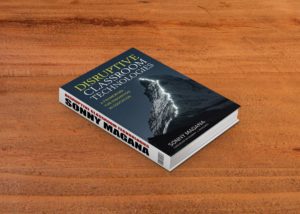 Originally posted at Marginalia Magazine
Originally posted at Marginalia Magazine
How far are education professionals equipping students for the world they will face when they leave their classrooms and enter the world of work?
Sonny Magana (pictured right), author 0f Disruptive Classroom Technologies, contrasts two possible future scenarios:
In the first scenario, educational professionals will continue to engage in the age-old “tell and practice” model of instruction. In this model, teachers tell students what knowledge is important for them to know, what that knowledge is, and then have students memorise that knowledge to report it back to their teachers, or to take an examination. The overarching goal of this model is for students to accurately repeat what they have been told.
Unfortunately, there is very little thinking involved in this model—on either the part of the teacher or the student. “When these types of instructional and administrative practices are translated from an analogue realm into a digital realm—in other words, when technologies are simply overlaid onto the “tell and practice” model of teaching and learning—the resulting impact on student achievement is dismally low,” explains Magana.
This has been the effect of computer technology in education for the past 50 years, despite extraordinary advances in those technology since the mid 1960s. “If this model doesn’t change,” the author points out, “then we should expect the same meager impact of new and emerging technologies on instructional quality and student achievement for the next 50 years or more.”
In the second future scenario, however, teachers begin to use technology to transform their roles from tellers of information to facilitators of student knowledge generation. “Students will begin to use technology to produce digital knowledge artifacts that represent what they know, what they can do, and how they think about their knowledge growth.”
Students will also use technology to archive and make accessible their own digital knowledge products that are designed to teach others what they know. “In this future scenario, students shift from passive consumers of content information to active and social knowledge architects, building ever expanding networks to expand their innate desire for interdependent creativity and communication,” says the author.
Moreover, in this second future vision, students will wield digital tools to transcend the historic processes and expectations of K-12 education by designing new and original lines of inquiry to identify, investigate, hypothesize, and iteratively build ever more robust digital solutions to wicked problems that matter to them. “The impact of transformational and transcendent technology use simply explodes the glass ceiling of student learning, achievement, and contribution.”
The role of the teacher in this possible future will naturally shift from that of “transmitter of knowledge” to “facilitator of knowledge generation.” “This will take some time, but teachers and students are ready, willing, and able to make this shift. When this happens, the entire educational system will be reformed from within.”
To give an example, Magana shares the story of 11-year-old Mikaila Ulmer from Austin, Texas, which is featured in the author’s book. “The wicked problem that matters to Mikaila is the decimation of Apis mellifera—the honeybee. A condition known as colony collapse disorder has been annihilating the population of these apex pollinators across the planet, with potentially devastating effects on foods that require pollination; think about all the fruits, nuts, and vegetables that require bees to flourish. Using social media and a variety of software tools, Mikaila applied her social entrepreneurship efforts by founding her own company, Me & the Bees Lemonade, featuring locally sourced honey. A portion of the profits from this successful venture is donated to philanthropic organisations dedicated to saving bees from extinction. Moreover, Mikaila continues to work toward the common good by building an app that will educate students around the world about the dangers facing honeybees and steps they can take to stop the bees’ decline.”
